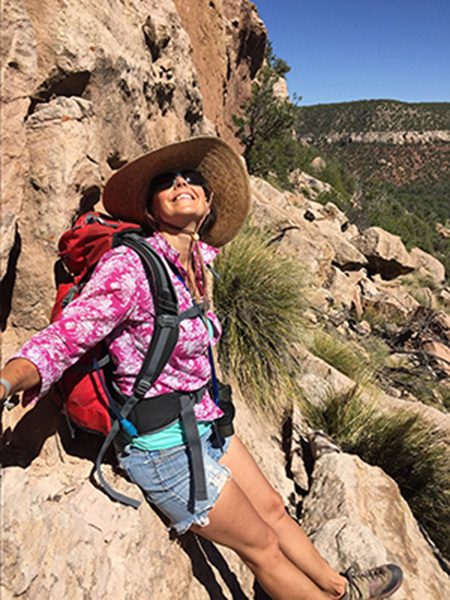“The doors to the world of the wild Self are few but precious. If you have a deep scar, that is a door, if you have an old, old story, that is a door. If you love the sky and the water so much you almost cannot bear it, that is a door. If you yearn for a deeper life, a full life, a sane life, that is a door.”
― Clarissa Pinkola Estés, Women Who Run With the Wolves: Myths and Stories of the Wild Woman Archetype
The term “wilderness” conjures for many people images of dense, dark forests populated by slavering wild animals—a place of being lost, frightened, and alone. This is especially true for urban dwellers, which means the majority of the population of this country has little frame of reference for a positive impression of wilderness. These people might not have ever backpacked, ever slept under the stars, ever watched a wolf as it trotted across a meadow at dusk.
With that in mind, how could wilderness matter to a person who lives in downtown Houston, Texas, for example—someone who walks always on pavement and whose only experience of nature might be under the trees in a local urban park? Why does wilderness matter, really? And why should it matter to women, especially?
My organization, the New Mexico Wilderness Alliance, has been on the frontlines of wilderness protection for twenty years. We have grappled with the challenge of keeping wilderness relevant in today’s digital, virtual, mechanical world. It’s admittedly an uphill battle. The world’s first wilderness area was established in southwestern New Mexico in 1924—the Gila Wilderness. Aldo Leopold was its most prominent champion, though he has been joined by many people over the decades who also recognized the sublime characteristics of this area and how special it is. The Gila Wilderness is home to the headwaters of the state’s last free-flowing (undammed) river, which also bears the name Gila. It’s the last place in this country where it’s possible to glimpse a Mexican gray wolf, the most endangered wolf subspecies in the world. Though the idea of wilderness literally began in New Mexico, the state lags far behind other western states in the amount of lands set aside as Wilderness: less than 2%.
Many people don’t even know what Wilderness—with a capital “W” really is. On designated Wilderness land, motorized or mechanized modes of transport are not permitted. Only Congress may designate a Wilderness, which is generally 5,000 acres or more, and is described in the 1964 Wilderness Act as “an area where the earth and its community of life are untrammeled by man, where man himself is a visitor who does not remain.” Notice the prominent use of “man.” Of course, this is implied to include women as well, as in “mankind.” But historically, this country’s wildest places have been primarily the domain of men—hunting, fishing, adventuring, outdoorsy, manly men. It’s no wonder that women are intimidated by the idea of strapping on a backpack and stepping into a roadless area, without cell service, populated by unknown wildlife. To suggest that it has relevance to our lives seems to be a stretch.
The error in the assumption that wilderness has no relevance in the lives of contemporary urban women is grounded in a perception that the influence of a wilderness area begins and ends within its boundaries. As in the case of the Gila, many of our precious rivers have their headwaters within Wilderness, or run through wilderness. The elevated protections offered to a landscape by official Wilderness designation means that watersheds, which are the source of water for many communities nationwide, remain unpolluted by development.
The economic benefit to communities adjacent to wilderness areas has been demonstrated repeatedly. Studies show that wilderness enhances nearby property values. The costs of public services tend to be lower in areas where conservation lands exist. Tourism and the businesses that support it, such as hotels, tour companies, and restaurants, can buoy a community’s economy. Wilderness protects open space, natural soundscapes, diverse ecosystems, and biodiversity. Most wilderness areas are also carbon sinks, which help combat climate change. As the migration habits of animals shift in response to climate change, keeping intact migration corridors through wildlands is increasingly critical to their survival.
So this is all well and good for people generally, but why is wilderness especially important for women? There are several reasons, the most powerful of which is the fact that wilderness doesn’t recognize gender. It’s the great equalizer. Anyone, with ability to be able to, can enter a wilderness area and experience nature at its most pristine and unsullied. Whether you’re a man or a woman, wilderness doles out the same opportunities for beauty, solitude, and peace to your soul. You’ll have equal opportunity to be challenged, to enjoy a slowing of life’s tempo, to unplug from the demands of instant communication and the white noise of modern life. Are there wild animals? Yes. And a woman is far more likely to be assaulted in a city than she is to be attacked by an animal in nature. It’s a fear-based, media-fed myth that has cut us off from our birthright to wild places, and we are poorer for it.
As the primary caregivers of our children, we have the opportunity to gift them with a sense of their own power and wildness by introducing them to the wilderness near them. As role models, being in touch with our own wild world can open the door for the next generation. Women who don’t feel confident bringing their kids into wilderness can learn skills from organizations like Boulder, CO-based Women’s Wilderness, which hosts classes, workshops, and camps for women and their kids. Many nonprofit organizations like the New Mexico Wilderness Alliance offer hikes, trips, and volunteer service projects that allow a woman and her family the opportunity to experience wilderness in a safe, supported way.
Women who are physically unable to journey into a wilderness area can still benefit. Just knowing that wilderness exists can produce a sense of curiosity, inspiration, renewal and hope. The quote at the beginning of this article refers to the essential knowledge we all have—that the wild spirit in ourselves is ever tied to the wild places on this earth. One cannot exist without the other.
Not everyone believes in the rights of women as sovereign, self-actualized, equal members of society. Similarly, not everyone appreciates wilderness or believes in the right of wild places to exist for their own sake. They claim that all land exists to be exploited, that the only value a mountain has is as a source of income or raw materials. Women are no strangers to exploitation in the name of profit. In a country that has, since its earliest exploration, been logged, grazed, mined, trapped, and farmed to the point of unrecognizability, we see hope for the future in those last remaining scraps of true wildlands that are still relatively untrammeled. Wilderness belongs to all of us, and we need it now, more than ever.
 This Women of Green guest blog is by Lois Manno. Living more than 30 years in New Mexico has given Lois Manno a great appreciation for this state and its wild country. She serves as Membership Coordinator for the New Mexico Wilderness Alliance, helping to promote wildlands protection statewide. She has a background in nonprofit administration and has volunteered for many years as a project caver for various land management agencies. She is a Fellow of the National Speleological Society and the Cave Research Foundation. Lois is the author of the award-winning book Visions Underground: Carlsbad Caverns Through the Artist’s Eye, a history of the photographers and other artists who have been inspired by Carlsbad Caverns from 1900 till today. She makes fused glass art in her spare time; see her work at www.glassbirdstudios.com.
This Women of Green guest blog is by Lois Manno. Living more than 30 years in New Mexico has given Lois Manno a great appreciation for this state and its wild country. She serves as Membership Coordinator for the New Mexico Wilderness Alliance, helping to promote wildlands protection statewide. She has a background in nonprofit administration and has volunteered for many years as a project caver for various land management agencies. She is a Fellow of the National Speleological Society and the Cave Research Foundation. Lois is the author of the award-winning book Visions Underground: Carlsbad Caverns Through the Artist’s Eye, a history of the photographers and other artists who have been inspired by Carlsbad Caverns from 1900 till today. She makes fused glass art in her spare time; see her work at www.glassbirdstudios.com.
.
Women of Green is TURNING UP THE VOLUME of the feminine voice on the planet in order to create the world we know is possible.
